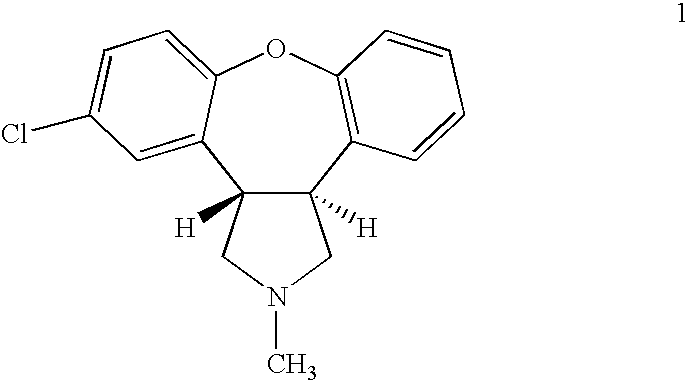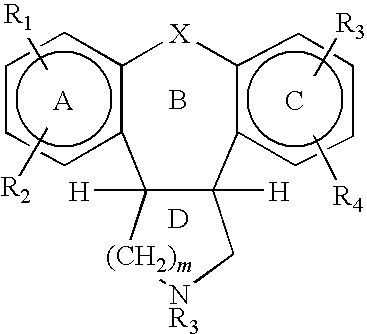Process for making asenapine
a technology of asenapine and process, applied in the field of asenapine production process and intermediate, can solve the problems of insufficient synthesis, inability to achieve optimal synthesis, and inability to obtain the desired trans-isomer of amide (6) or (6a) in low relative amounts,
- Summary
- Abstract
- Description
- Claims
- Application Information
AI Technical Summary
Benefits of technology
Problems solved by technology
Method used
Image
Examples
example 1
Compound (8)
[0071]Step 1—Preparation of Compound (12):
[0072]Potassium t-butoxide (2.52 g) was suspended in freshly dried diethyl ether (50 ml). Under cooling and while stirring, dimethyl oxalate (3.19 g) was added, followed by addition of the compound (2-E) (R=methyl) (5.0 g) in diethyl ether (10 ml). The mixture was stirred at ˜5° C. for 1 hour and then at room temperature for 20 hours. The mixture was poured into ice (100 g) and stirred for 5 minutes. The separated water layer was acidified with 2M HCl to pH 1.5 and extracted with diethyl ether (100 ml). The ether-extract was washed with brine (15 ml), dried and concentrated to give a crude product (12) (5.5 g).
[0073]Step 2—Cyclization of (12) to Anhydride (13):
[0074]A mixture of compound (12) (15 g) and polyphosphoric acid (120 g, 82% min. as P2O5) was stirred at 120° C. (oil bath) for 50 minutes and then at 130° C. for 1 hour. After cooling down to room temperature, water (250 ml) was added carefully followed by diethyl ether (2...
example 2
Synthesis of Asenapine (1)
[0079]Step 1—Reduction of En-dimethylester (8) to the Dimethyl Ester (9):
[0080]A mixture containing 1.1 g (3.2 mmol) of en-dimethylester (8, R1=R2=methyl) and magnesium (0.5 g, ˜20 mmol) in a mixture of tetrahydrofuran (5 ml) and methanol (25 ml) was stirred at 60° C. (oil bath) for 1 hour. Magnesium disappeared completely. After the reaction mixture was cooled down to room temperature, acetic acid (2.4 ml) was added and further stirred for 10 minutes.
[0081]The mixture was concentrated in vacuo and then re-dissolved in chloroform (50 ml). The organic layer was washed with water (50 ml), brine (25 ml), dried and concentrated to give a desired product (1.1 g). Trans-cis ratio was 97:3 based on HPLC.
[0082]Step 2—Reduction of (9) to di-alcohol (14):
[0083]To a solution of dimethyl ester (9) from the preceded step (˜1.1 g) in pre-dried THF (25 ml), under cooling (ice water) and while stirring, a solution of LiAlH4 (4 ml, 2M in THF) was added in ˜20 minutes. After...
PUM
| Property | Measurement | Unit |
|---|---|---|
| temperatures | aaaaa | aaaaa |
| temperature | aaaaa | aaaaa |
| pH | aaaaa | aaaaa |
Abstract
Description
Claims
Application Information
 Login to View More
Login to View More - R&D
- Intellectual Property
- Life Sciences
- Materials
- Tech Scout
- Unparalleled Data Quality
- Higher Quality Content
- 60% Fewer Hallucinations
Browse by: Latest US Patents, China's latest patents, Technical Efficacy Thesaurus, Application Domain, Technology Topic, Popular Technical Reports.
© 2025 PatSnap. All rights reserved.Legal|Privacy policy|Modern Slavery Act Transparency Statement|Sitemap|About US| Contact US: help@patsnap.com



